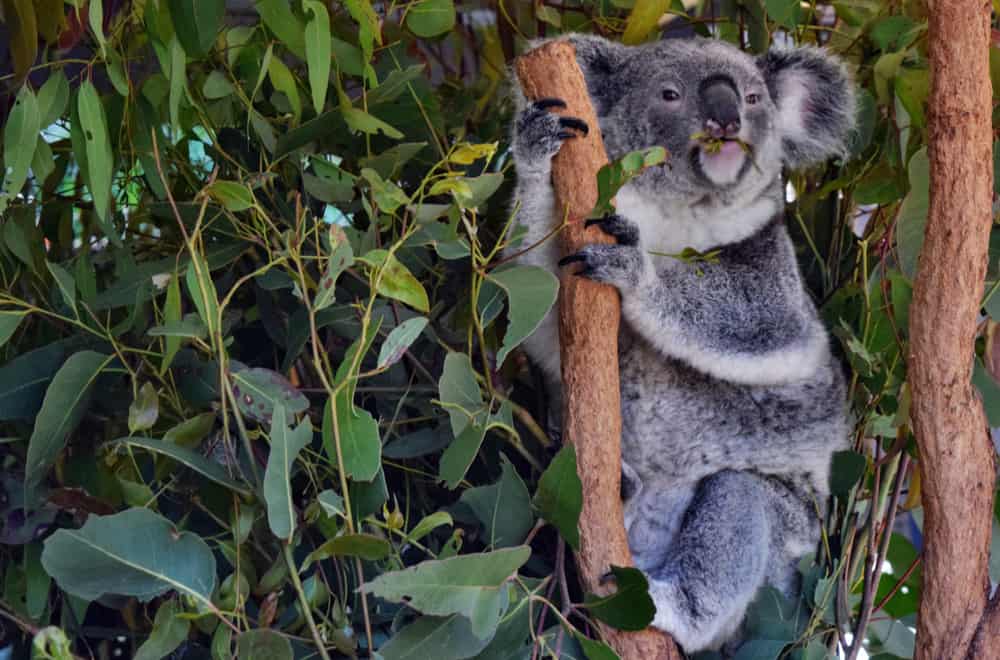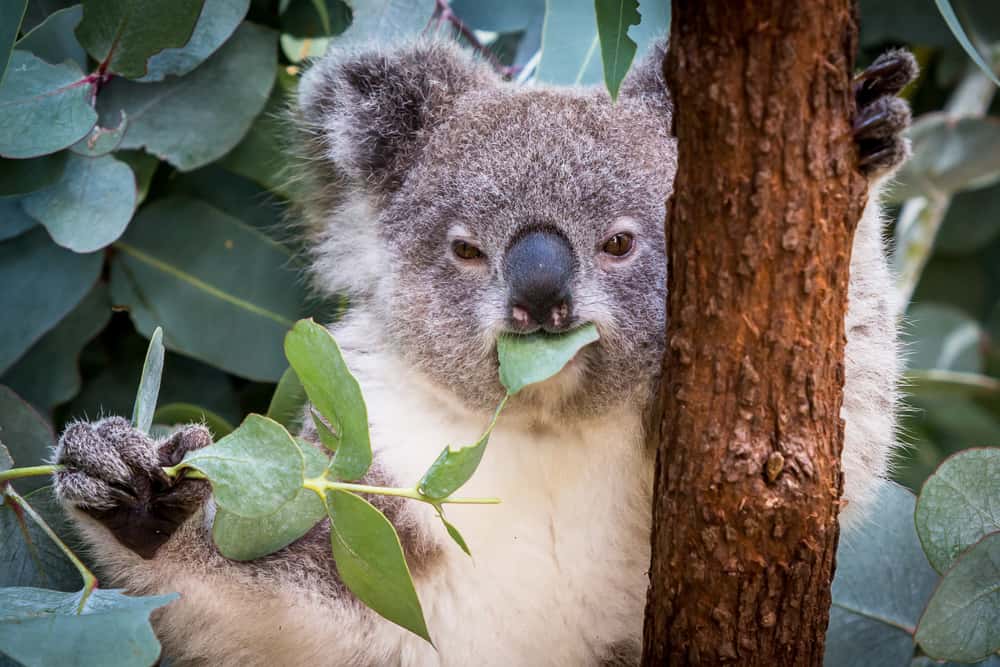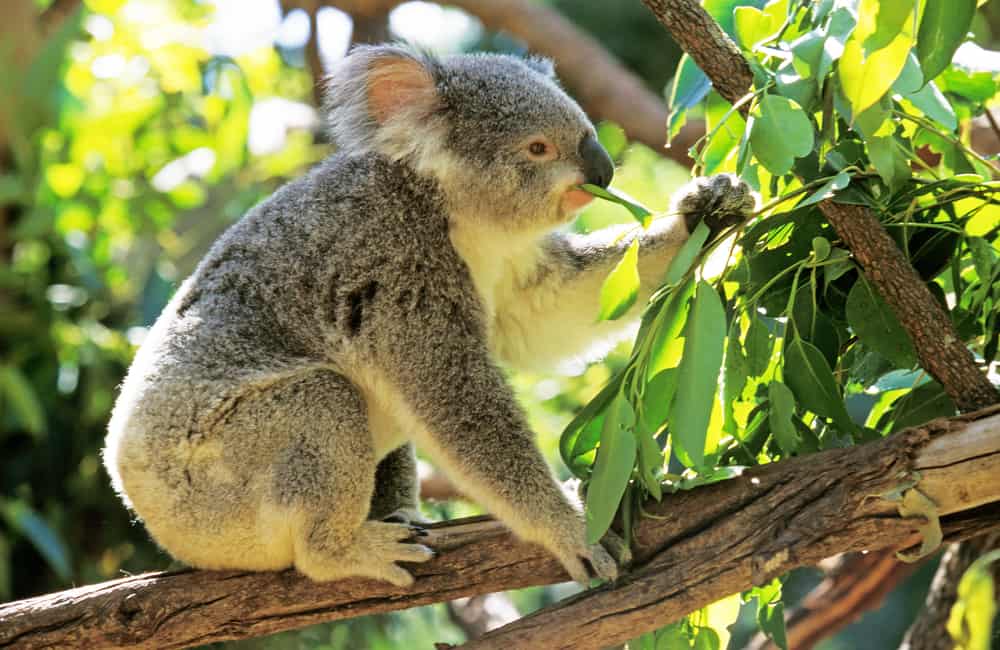When you think of Australia, aside from kangaroos, koalas will, without a doubt, cross your mind. They are cute tiny mammals at whatever age they are. You probably know them for their tendencies to climb and hug trees.
For those of you that wonder what do koalas eat? This feature holds the answer to this question.
Koalas Habits And Biology
Koalas (Phascolarctos cinereus) or koala bears are sometimes known as herbivorous marsupials native to Australia. Marsupials have pouches on their bellies and give birth to underdeveloped babies. Other examples include kangaroos and wombats.
Koalas mainly inhabit eucalyptus forests in Queensland, South Wales, Victoria, and Southern Australia.
You can easily recognize koalas by their stout, tailless bodies, round heads, fluffy ears, and spoon-faced noses. The average koala stands at 60-85 centimeters tall and weighs between 4-25 kilograms.
Their large ears help them hear well, and both male and female koalas can identify mates from a distance.
Koalas climb trees to reach food due using their sharp claws. They also possess strong thigh muscles that further help them climb effectively.
Male koala bears are distinctively larger than their female counterparts, with males being 50% larger than females. They can be further told apart from females by the presence of their large noses and scent glands on their chests, revealed by hairless patches.
Koala bears are asocial animals meaning they don’t bond much with each other and other animals. Bonding is commonly seen mainly between mothers and their offspring (joeys).
Male koalas mark the areas they rule with secretions from their scent glands found on their chests. They also establish their territories close to females.
Koalas communicate by making noises known as bellows. Adult males use bellows to intimidate rivals and attract females. Female koalas also communicate using bellows but in lower tones.
Koalas, like other marsupials, give birth to underdeveloped young ones that have to crawl to their pouches. Joeys will remain in their mother’s pouches for the first 6 to 7 months of their lives. Joeys are weaned off their mother’s milk after a year.
Koalas can live for 12 to 14 years in the wild, whereas in captivity, they live longer. Their lifespan under the care of trained individuals is 16 to 20 years.
What Do Koalas Eat In The Wild?
Koalas are strict herbivores and therefore only feed on plant matter. Did you know they primarily feed on the leaves of the eucalyptus trees?
Out of the 600 species of eucalyptus, koalas only feed on the leaves of 30 species. They do so due to the high protein content found in these selected species. Koalas can additionally feed on the flowers, bark, stems, and buds of the eucalyptus tree.
Koalas, when eating, use their hind paws and one fore-paw to hold their food. They use their incisors for grasping leaves and molars and premolars to chew and grind their food.
Middle-aged koalas use their slightly worn-out premolars for breaking and crushing leaves into small pieces. This adaptation, in turn, results in efficient stomach digestion and absorption of nutrients in the small intestines.
Like cows, koalas sometimes regurgitate (to bring swallowed food back to the mouth) food in their mouths for further chewing. Furthermore, koalas have small pouches in their cheeks to store food before it is ready to be chewed.
Koalas eat and sleep on the same tree for about a day before moving on to another tree. They typically consume about 500 grams of food in a day, the same as eating small lettuce. Female koalas will eat more leaves when lactating.
Koala bears hardly ever drink water because eucalyptus leaves contain a sufficient amount of water to sustain them.
Eucalyptus leaves contain numerous toxic substances similar to that of cyanide, which many animals can’t eat. Koalas possess the ability to break the toxins using their specialized digestive systems. They will typically feed on leaves that contain the least amount of toxins.
Using their hard molars, koalas effectively grind down the leaves into a paste, allowing easy absorption by the stomach. The toxins are isolated by the liver and excreted in the form of urine and feces.
Breakdown of the remaining food takes place in a long coiled sac that branches out from the large intestine called the caecum in the presence of specialized bacteria.
Koalas are not born with bacteria. Instead, their mother passes it down to them by excreting pap that the joey eats. Pap is a sticky, runny fecal substance that provides the young koala with the bacteria needed to eat the leaves when they become adults.
Facts About Koalas
If you find koalas interesting, well, there’s more to find out about these magnificent animals. Read on to learn more facts about these pouched mammals.
- Initially, indigenous Australians hunted koalas.
- You can hear the koalas bellow from s far as 800 meters away.
- Australian laws prevent koalas from being kept as pets.
- Koalas can sometimes have white fur. These koalas are known as albino koalas. The first albino koala was born in 1985 at the San Diego zoo.
- The koala bears will also hug trees to cool down on extremely hot days.
- An anonymous photographer recorded the first European-koala encounter in 1798. In 1810, naturalist George Perry published the first image of the koala.
- In 1814, Robert Brown wrote the first comprehensive scientific description of the koala. However, his work remained unpublished for 180 years.
- John Gould’s drawing and description of the koala first introduced it to the general British public.
- Universally the koala bear is recognized as the symbol of Australia because of its distinct appearance.
- During the early 20th Century in Queensland, koalas were heavily hunted for their fur. Overhunting of koalas led to a public outcry, and the people of Queensland formed a movement to protect the species.
- Koalas have tiny brains in proportion to their body weight in comparison to other animals. They are unable to perform new tasks. For example, they will not eat leaves of a flat surface. They can’t change or adapt their behavior from their regular feeding routine.
- Koalas have two thumbs on each paw that they use for grasping objects and grooming themselves.
- Koalas are prone to a variety of diseases that can affect their life expectancy. The bacteria chlamydia infects koalas in South East Queensland. The disease may cause blindness in koalas and can lead to infertility in female koalas.
- Other than human beings and primates, koalas are the only mammals that have fingerprints. And like humans, each individual’s print is unique. Additionally, they also have distinct patterns on their noses that help wildlife biologists track and identify them.
- On May 3rd, Australians celebrate wild koalas day. People will pin eucalyptus leaves or any other leaves on their shirts and share the animals’ pictures on social media.
- Koalas are incredibly unique creatures. Many people think they are related to bears, but their closest living relatives are wombats.
- Male koala bears typically have foul odors due to the scent glands on their chests. Female and young koalas, however, smell more like eucalyptus, which doubles up as insect repellents.
- Koalas are by law a protected species in Australia and are not listed as endangered. Despite this fact, their habitats are under threat. Their homes are vulnerable to bush fires, and human beings cut down their trees to build houses.
- The Australian Koala Foundation (FKF) estimates that as little as 43,000 koalas are left in Australia today.
- Koalas have few predators, such as the dingo, python, owls, and also eagles. However, adult koalas are not the best choice of prey for most of these animals.
- The world’s oldest koala lived up to 23 years. It was known as Sarah, and it lived in the Lonepine Sanctuary, the first and the largest koala sanctuary.
Frequently Asked Questions (FAQs)
Do eucalyptus leaves make koalas sleep?
No, they don’t. Eucalyptus leaves provide the koalas with very little energy. Therefore they conserve energy by sleeping for long hours.
Koalas need the energy to move between trees they feed on, digestion, escaping predators, and looking for partners during the breeding season.
How fast do koalas move?
Koalas are not only fast and expert tree climbers but also very quick on the ground. They can achieve speeds of up to 20-30 kilometers per hour over short distances.
Because they need to conserve energy, koalas only run when necessary. For example, when escaping a predator.
Are koalas nocturnal mammals?
It wouldn’t be accurate to classify koalas as nocturnal despite the long hours of sleep they enjoy during the day. Koalas sleep through the heat of the day to conserve energy for feeding during the cooler nights.
Therefore, koalas are crepuscular as they are slightly active during the day and active at night. This is due to their constant need to feed and conserve energy.
Summary
Spotting a koala in the wild is easy due to its distinct features. Despite their incapability to adapt, it’s incredible how koalas can survive from simply eating one type of food.
That leads us to the end of the article concerning “what do koalas eat?”


